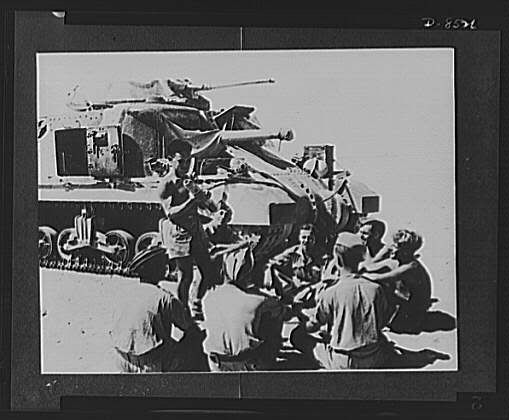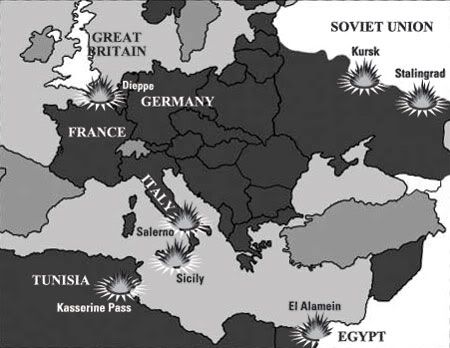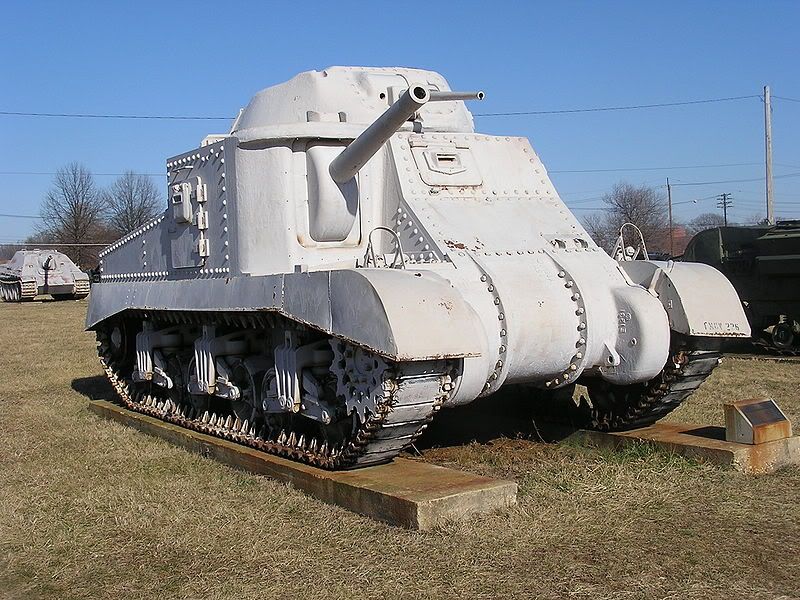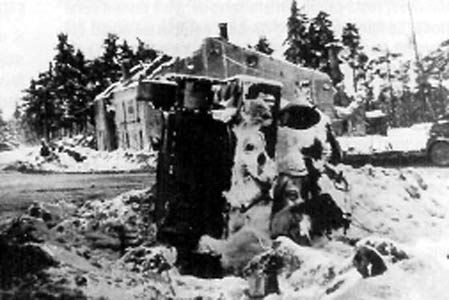 It was the 9/11 of the 1940s. For the first time since the War of 1812, a foreign power had attacked the homeland of the United States. The economy still had not recovered completely from the Great Depression, and wartime rationing quickly took effect. It was in these conditions a wartime photographer took British tank men study U.S. tanks between battle in Egypt…A gunner giving a talk on the 75mm gun (British tank men).
It was the 9/11 of the 1940s. For the first time since the War of 1812, a foreign power had attacked the homeland of the United States. The economy still had not recovered completely from the Great Depression, and wartime rationing quickly took effect. It was in these conditions a wartime photographer took British tank men study U.S. tanks between battle in Egypt…A gunner giving a talk on the 75mm gun (British tank men).This photograph makes two distinct arguments, one to the original audience and another to 21st century viewers. To the original viewers of British tank men, the pathos and logos generated from the vectors of attention, saturation, and framing inspired a feeling of nationalism and reflected the belief of American superiority. To the modern viewer, those same technical elements speak of sadness and disappointment.
 In order to understand the arguments made in this photograph, it is important to be familiar with its historical context. The German military’s strength was its mobility. It swept through Poland, the Netherlands, Belgium, and France in a very short time using a new strategy known as the blitzkrieg (lighting war). Essentially, the Germans used their overpowering Panzer tanks to brush away any resistance. By 1941, this tactic had allowed Germany to annex or conquer all of continental Europe, and the Allies had no answer for the might of the Panzer. That is where the tank pictured in British tank men, the M3 Lee, came in. It was supposed to be able to match the firepower of its German counterparts.
In order to understand the arguments made in this photograph, it is important to be familiar with its historical context. The German military’s strength was its mobility. It swept through Poland, the Netherlands, Belgium, and France in a very short time using a new strategy known as the blitzkrieg (lighting war). Essentially, the Germans used their overpowering Panzer tanks to brush away any resistance. By 1941, this tactic had allowed Germany to annex or conquer all of continental Europe, and the Allies had no answer for the might of the Panzer. That is where the tank pictured in British tank men, the M3 Lee, came in. It was supposed to be able to match the firepower of its German counterparts. The first and most important element used by the photographer in British ta nk men is vectors of attention. When the viewer first sees this photograph, his eyes are immediately drawn to the tank. This is the main focal point of the picture, and the photograph uses the tank (an M3 Lee) to make its main arguments. The M3 was the height of American military innovation and design. By making this monument to the power of the United States the main focus of the picture, the photograph reminded its original viewers that the US was had the capability to win the war. Pearl Harbor was still very much on the minds of Americans of this period. Through the picturing of the greatest American weapon of war, Americans were reminded of their nation’s might, and inspired to work toward victory.
nk men is vectors of attention. When the viewer first sees this photograph, his eyes are immediately drawn to the tank. This is the main focal point of the picture, and the photograph uses the tank (an M3 Lee) to make its main arguments. The M3 was the height of American military innovation and design. By making this monument to the power of the United States the main focus of the picture, the photograph reminded its original viewers that the US was had the capability to win the war. Pearl Harbor was still very much on the minds of Americans of this period. Through the picturing of the greatest American weapon of war, Americans were reminded of their nation’s might, and inspired to work toward victory.
 nk men is vectors of attention. When the viewer first sees this photograph, his eyes are immediately drawn to the tank. This is the main focal point of the picture, and the photograph uses the tank (an M3 Lee) to make its main arguments. The M3 was the height of American military innovation and design. By making this monument to the power of the United States the main focus of the picture, the photograph reminded its original viewers that the US was had the capability to win the war. Pearl Harbor was still very much on the minds of Americans of this period. Through the picturing of the greatest American weapon of war, Americans were reminded of their nation’s might, and inspired to work toward victory.
nk men is vectors of attention. When the viewer first sees this photograph, his eyes are immediately drawn to the tank. This is the main focal point of the picture, and the photograph uses the tank (an M3 Lee) to make its main arguments. The M3 was the height of American military innovation and design. By making this monument to the power of the United States the main focus of the picture, the photograph reminded its original viewers that the US was had the capability to win the war. Pearl Harbor was still very much on the minds of Americans of this period. Through the picturing of the greatest American weapon of war, Americans were reminded of their nation’s might, and inspired to work toward victory. After the tank, the viewer’s attention is drawn to the actual soldiers in the picture. The vectors of attention of the soldiers themselves is extremely important to the argument this photograph was making to American civilians.
The British soldiers in the picture are obviously not looking at the camera. They are instead looking toward their instructor, an American. By situating the American at the head of the semicircle and showing the British soldiers learning from him, the photograph is once again appealing to the nationalism of Americans. The United States and Britain, despite being allies, had not always worked well together in war. In WWI, the British attempted to dismantle the US Army units shipped to Europe and instead use American soldiers as replacements for fallen British troops. To a lesser extend, British pride showed itself in WWII as well. The British had been fighting the Germans for four years across Europe, while the United States did not join until provoked by Japan. British arrogance did not take long to show itself once again in WWII.
The vectors of attention show otherwise, reminding Americans and the world of American ingenuity. It is not the British who are teaching the Americans, but the Americans who are teaching the British how to fight the Germans. The logos of the vectors of attention of the British soldiers appeal to a pathos of nationalism and determination.
Yet, while most of the British are looking at the American, one soldier is looking directly at the camera. He seems to be looking at the audience, reminding them the war is very real. This helps to draw the audience into the picture, and even gives the audience a feeling of sympathy for the soldiers. This would reinforce the appeals to Americans’ resolve in “getting the boys home.”
Finally, the American soldier is not shown looking at his students or the tank. He is instead looking at the shell in his hands. He sees that it is the most important thing to both him and his students. They have all most likely seen combat before, and seen the destruction the Panzers could cause. This shell could save his life, destroying the Panzer before the Panzer de stroys him. Including this in the picture not only appeals to nationalism, but reminds the American people of the horrors of war. People will die on both sides, but the ingenuity and might (shown through the tank and the shell) of the Allies would win in the end.
stroys him. Including this in the picture not only appeals to nationalism, but reminds the American people of the horrors of war. People will die on both sides, but the ingenuity and might (shown through the tank and the shell) of the Allies would win in the end.
Finally, the American soldier is not shown looking at his students or the tank. He is instead looking at the shell in his hands. He sees that it is the most important thing to both him and his students. They have all most likely seen combat before, and seen the destruction the Panzers could cause. This shell could save his life, destroying the Panzer before the Panzer de
 stroys him. Including this in the picture not only appeals to nationalism, but reminds the American people of the horrors of war. People will die on both sides, but the ingenuity and might (shown through the tank and the shell) of the Allies would win in the end.
stroys him. Including this in the picture not only appeals to nationalism, but reminds the American people of the horrors of war. People will die on both sides, but the ingenuity and might (shown through the tank and the shell) of the Allies would win in the end. This picture was taken in North Africa during spring or summer with a 1940s black and white camera. Therefore, the coloration is slightly altered by the limitations of period technology. However, there are specific elements within British tank men which could not be unintentional. These two purposeful elements are saturation and contrast.
The photograph is super-saturated. In fact, it is so saturated that the background appears completely white. This creates a surreal, dreamlike pathos, painting an idealized picture of war. Even though things like the shell and tank remind viewers the war will be horrific, it also lets the audience feel some comfort. The dreamlike quality allowed WWII civilians to see the war as far away from American soil. This helped to calm fears about another Pearl Harbor. However, it also creates harsh and sometimes hard to distinguish transitions between the tank, men, and shell. This gives the picture somewhat of a gritty, chaotic feel, creating a sense of chaos and confusion in the viewer. This forces the audience to focus on key objects, such as the tank, soldiers, and shell. Thus, it calms the audience while simultaneously making an argument of nationalism and determination by focusing attention on the objects making the argument.
Finally, British tank men is framed to specifically show a very narrow field of vision. No tank would be alone during wartime, especially “in between battles,” as the picture’s title says. However, the photographer chose to intentionally omit anything but the tank and soldiers. In addition, the field of vision specifically includes the armament and turret of the tank. The framing makes the tank the main focus of the photograph, thus appealing once again to the national pride Americans took in their technological prowess. In addition, the decision to show almost no sky and foreground suggests the surroundings of the photograph were not particularly important. While the picture was taken in the North African desert, the photographer does not want us to focus on the location, but on the soldiers (appealing to determination to win and bring them home) and the tank (sparking a pathos of nationalism).
British tank men was essentially a propaganda picture used to inspire Americans to stay committed to the war effort. It was intended to create a sense of national pride, and it would have in the same sense pictures of American soldiers fighting in Afghanistan did after 9/11. However, to the modern viewer, the key elements in British tank men do not inspire pride. Instead, they create a pathos of disappointment.

American tanks during WWII were in fact far inferior to German tanks, and the M3 Lee was no exception (the tank in the above link is the M4 Sherman, the main US tank during the war). The shell the American is staring at was fired from a low-velocity canon, which could not pierce the Panzer’s frontal armor. The British were learning how to fight in a moving deathtrap. The tank itself was slow and was an extremely easy target for experienced Panzer gunners. Essentially, the very elements that once inspired patriotism now inspire remind Americans of the death resulting from inferior technology.
In its original context, British tank men gave American civilians a sense of national pride and determination through vectors of attention, saturation, and framing. To the 21st century viewer, the vectors of intention instead inspire a pathos of sadness and mourning. World War II was the largest war in the history of the world, taking more lives than any war in history. Through this one small snapshot of that war, we can see the determination and pride Americans took in their military and country.
No comments:
Post a Comment